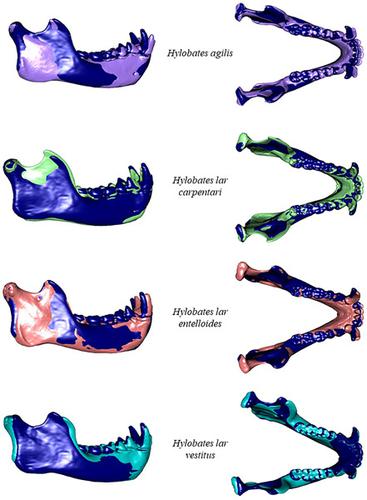当前位置:
X-MOL 学术
›
Am. J. Primatol.
›
论文详情
Our official English website, www.x-mol.net, welcomes your
feedback! (Note: you will need to create a separate account there.)
Mandibular shape variation in mainland and insular hylobatids.
American Journal of Primatology ( IF 2.0 ) Pub Date : 2020-07-22 , DOI: 10.1002/ajp.23175 M Kathleen Pitirri 1, 2 , Erin Vermeulen 1 , Klara Komza 1 , David R Begun 1
American Journal of Primatology ( IF 2.0 ) Pub Date : 2020-07-22 , DOI: 10.1002/ajp.23175 M Kathleen Pitirri 1, 2 , Erin Vermeulen 1 , Klara Komza 1 , David R Begun 1
Affiliation

|
Although hylobatids are the most speciose of the living apes, their morphological interspecies and intraspecies variation remains poorly understood. Here, we assess mandibular shape variation in two species of Hylobates, white‐handed (Hylobates lar) and black‐handed (Hylobates agilis) gibbons. Using 71 three‐dimensional landmarks to quantify mandibular shape, interspecies and intraspecies variation and geographic patterns of mandibular shape are examined in a mixed sex sample of adult H. lar and H. agilis through generalized Procrustes analysis, Procrustes analysis of variance, and principal components analysis. We find that relative to H. agilis, H. lar exhibits a higher amount of variation in mandibular shape. Both species demonstrate similar allometric patterns in mandibular shape. We also highlight a geographic pattern in mandibular shape variation. Compared to mainland hylobatids, insular hylobatids have relatively lower, more posteriorly oriented, and anteroposteriorly wider mandibular condyles, with an increased distance between the condyles and the coronoid processes. This geographic pattern could reflect differences in functional demands on the mandible during mastication and/or could be driven by factors often associated with evolutionary pressures of island populations relative to mainland populations. The findings of this study highlight how little is known about Hylobates morphological variation and how important this is for using Hylobates to help interpret the primate fossil record. Understanding interspecific and intraspecific variation in extant primates is vital to interpreting variation in the primate fossil record.
中文翻译:

下颌骨和离体绣球花的下颌形状变化。
尽管绣线虫是最活的类人猿,但它们的形态种间和种内变异仍然知之甚少。在这里,我们评估在两个物种的下颌形状变化长臂猿,白利手(长臂猿LAR)和黑色手(长臂猿AGILIS)长臂猿。通过广义Procrustes分析,Procrustes分析和主成分,使用71个三维地标来量化下颌骨形状,种间和种内变异和下颌骨形状的地理格局,并在成年H. lar和H. agilis的混合性别样本中进行检查。分析。我们发现相对于H. agilis,H。lar下颌骨形状变化较大。两种物种在下颌形状中都表现出相似的异形体模式。我们还强调了下颌形状变化的地理模式。与大陆性绣球虫相比,岛形绣球虫的下颌con骨相对较低,后向性更高,前后ero骨较宽,,突和冠状突之间的距离增加。这种地理模式可能反映出咀嚼期间对下颌骨功能需求的差异,并且/或者可能是由通常与岛屿人口相对于大陆人口的进化压力相关的因素驱动的。这项研究的结果突显出人们对Hylobates形态变异了解甚少,这对于使用刺舌帮助解释灵长类动物的化石记录。了解现存灵长类中的种间和种内变异对于解释灵长类动物化石记录中的变异至关重要。
更新日期:2020-08-26
中文翻译:

下颌骨和离体绣球花的下颌形状变化。
尽管绣线虫是最活的类人猿,但它们的形态种间和种内变异仍然知之甚少。在这里,我们评估在两个物种的下颌形状变化长臂猿,白利手(长臂猿LAR)和黑色手(长臂猿AGILIS)长臂猿。通过广义Procrustes分析,Procrustes分析和主成分,使用71个三维地标来量化下颌骨形状,种间和种内变异和下颌骨形状的地理格局,并在成年H. lar和H. agilis的混合性别样本中进行检查。分析。我们发现相对于H. agilis,H。lar下颌骨形状变化较大。两种物种在下颌形状中都表现出相似的异形体模式。我们还强调了下颌形状变化的地理模式。与大陆性绣球虫相比,岛形绣球虫的下颌con骨相对较低,后向性更高,前后ero骨较宽,,突和冠状突之间的距离增加。这种地理模式可能反映出咀嚼期间对下颌骨功能需求的差异,并且/或者可能是由通常与岛屿人口相对于大陆人口的进化压力相关的因素驱动的。这项研究的结果突显出人们对Hylobates形态变异了解甚少,这对于使用刺舌帮助解释灵长类动物的化石记录。了解现存灵长类中的种间和种内变异对于解释灵长类动物化石记录中的变异至关重要。









































 京公网安备 11010802027423号
京公网安备 11010802027423号